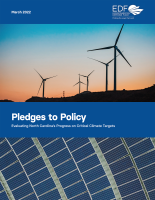
Guest commentary
This is the second in a commentary series by the nonprofit Environmental Defense Fund.
The most recent International Panel on Climate Change (IPCC) report made clear that we are running out of time to stymie the worst impacts of climate change. The report demonstrates that harmful climate impacts — such as worsening storms, extreme heat, and rising sea levels that threaten North Carolina’s iconic coast, to name a few — will worsen faster than we have time to adapt. But there is still hope — a small window of time left to rapidly reduce greenhouse gas (GHG) emissions and invest in resilience to avoid the worst impacts of our warming climate.
Supporter Spotlight
Thankfully, North Carolina has committed to do its part in combating climate change by reducing climate warming pollution, but a new report from Environmental Defense Fund (EDF) shows a substantial gap between the state’s pledges and policy results. Gov. Roy Cooper will need to take decisive action, or North Carolina risks falling short of reaching its own climate goals.

Gov. Cooper has taken steps to signal North Carolina’s leadership on climate policy by joining the U.S. Climate Alliance and issuing Executive Order 80 in 2018 and Executive Order 246 in 2022. These orders established important climate targets for the state — committing to reduce emissions across the economy by 40% by 2025 and achieve at least 50% reduction by 2030, respectively. Gov. Cooper’s orders also set targets for zero-emission vehicle sales, and called on the N.C. Department of Environmental Quality to develop a Clean Energy Plan (CEP), which recommended that the state reduce carbon pollution from the electric power sector 70% from 2005 levels by 2030 and achieve net-zero emissions by 2050. In late 2021, these power-sector targets were codified in House Bill 951, which requires the North Carolina Utilities Commission (NCUC) to take all reasonable steps to reduce power sector carbon pollution in line with the CEP recommendations. A process to chart the pathway to achieving that goal is currently underway, and will be adopted at the end of this year.

North Carolina has kicked off a series of important pledges and plans, but the true test of climate leadership is found not in plans and pledges, but in delivering results. Success requires moving from setting targets to deploying policies that drive down pollution. EDF’s new analysis shows that with current policies in place, North Carolina will not reduce emissions at the pace and scale necessary to meet EO 80’s 2025 or EO 246’s 2030 goals. In fact, after 2025, climate pollution levels are projected to remain flat or potentially rise in the long-term. With the policies in place as of May 2021, North Carolina is projected to reduce emissions 27% from 2005 levels by 2025, short of EO 80’s 40% reduction target. Depending on future costs and economic trends, emissions will stay at that level, or potentially increase, bumping the state back to just 16% emissions reductions from 2005 levels by 2030, and leaving a sizable gap to reaching the state’s climate goals. Even if North Carolina achieves the power sector carbon reduction targets set by HB 951 without delays, the state could only achieve a 28% to 38% reduction across the economy by 2030, still well short of EO 246’s 2030 target of cutting emissions in half.
The North Carolina Department of Environmental Quality’s (DEQ) own projections for 2030 shows a comparable gap between projected climate pollution levels and the state’s targets. These two analyses demonstrate that even while there is some uncertainty in future emissions trajectories, it is evident the state is not on track to achieve its targets.
Coupled with the recent warnings from the IPCC, these reports underscore the urgent need for swift policy action to close the emissions gap. Because greenhouse gas emissions remain in the atmosphere and continue to warm the planet for decades after they are emitted, early cuts in pollution will be essential to averting the most harmful climate impacts.
Supporter Spotlight
To build upon the foundation of the state’s climate goals, Gov. Cooper should swiftly implement policies that curb emissions in line with his Executive Orders. Since clean electricity is key to cleaning up other sectors, like transportation and buildings, implementing a strong Carbon Plan and complementary policies that consistently drive out fossil fuels and expand clean energy will be a “make or break” factor in achieving both power-sector and economy-wide goals. And while EO 246 takes an important step in setting a goal to reach over 1.2 million registered zero-emission vehicles by 2030, North Carolina will need to act on policy solutions that can achieve those targets while simultaneously driving down pollution from existing fleets. Another plan coming out of EO 246, the “Deep Decarbonization Pathways Analysis,” due in January 2023, will also be important for identifying pathways to decarbonize sectors across the economy. Once this new information is made available, the Cooper administration should swiftly turn this plan into concrete action.
Gov. Cooper has the opportunity over the next three years to use all the tools available to him to place the state firmly on the path to reduce climate pollution by at least 50% by 2030. Doing so would cement the state as a critical leader on climate action in the U.S. and globally; and, more importantly, would result in a cleaner, more climate-safe future for North Carolinians to live, work and play in for generations to come.
To stimulate discussion and debate, Coastal Review welcomes differing viewpoints on topical coastal issues. See our guidelines for submitting guest columns. Opinions expressed by the authors are not necessarily those of Coastal Review or the North Carolina Coastal Federation. Submissions may be edited for clarity.








